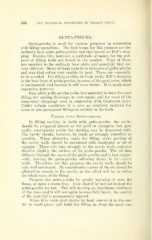Page 702 - My FlipBook
P. 702
360 THE TECHNICAX, PEOCEDUBES IK FILLING TEETH.
GUTTA-PERCHA.
Gutta-perclia is used for various purposes in connection
with filling operations. The best forms for this purpose are the
ordinary base plate gutta-percha and that known as Hill's stop-
ping. Besides this, however, a multitude of makes for the pur-
pose of filling teeth are found in the market. None of these
are superior to the ordinary base plate, and generally they are
very inferior. Many of them seem to be mixtures of gutta-percha
and wax that soften very readily by heat. These are especially
to be avoided. For filling cavities in front teeth, Hill's stopping
is the best form of gutta-percha, because of its good color, which
is maintained, and because it will wear better. It is much more
expensive, however.
Base plate gutta-percha is the best material we have for root
filling, for sealing dressings in root canals, and for most of the
temporary stoppings used in connection with treatment cases.
Under certain conditions it is also an excellent material for
more or less permanent fillings in cavities in the teeth.
Filling with Gutta-percha.
In filling cavities in teeth with gutta-percha, the cavity
should be prepared almost as for gold or amalgam, but, gen-
erally, convenience points for starting may be dispensed with.
The cavity should, however, be made as strongly retentive as
possible. When otherwise ready for filling, every portion of
the cavity walls should be moistened witli eucalyptol or oil of
cajuput. These oils take strongly to the cavity walls and also
dissolve slightly the surface of the gutta-percha. The oil then
diffuses through the mass of the gutta-percha and is lost, appar-
ently, leaving the gutta-percha adhering firmly to the cavity
walls. Therefore, for this purpose, the cavity walls should be
only well moistened. No considerable excess of the oil should be
allowed to remain in the cavity, as the effect will be to soften
the whole mass of the filling.
Prepare the gutta-percha by gently warming it over the
flame, or u]ion a warm tray. Care should be had not to heat the
gutta-percha too hot. This will develoja an inordinate stickiness
of the mass and it will not again become fully hard; the quality
of the material is permanently injured.
When it is made just plastic by heat, convey it to the cav-
ity in small pieces and build the filling uj) from the most con-


